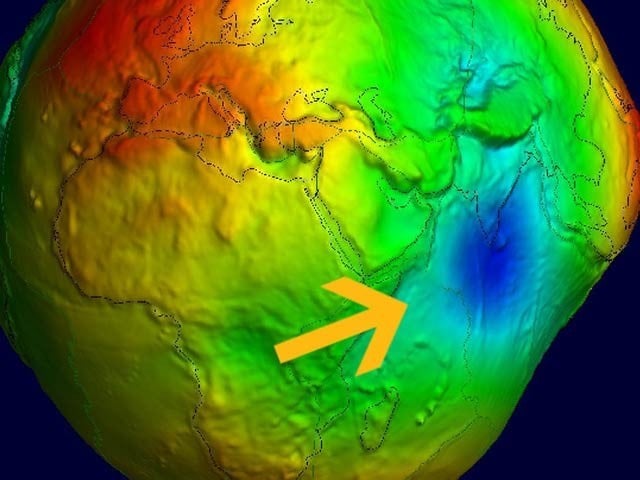Indian experts have discovered the secret of an unusual low-lying area in the depths of the Indian Ocean, which was considered a mystery until now. This location is highlighted as a blue spot in the image. Photo: Wikimedia Commons
Bengaluru: Pakistani sea Arabian Sea is actually a part of Indian Ocean. For a long time, a natural gravity well deep in the Indian Ocean has puzzled experts, and now experts may have found out the reason.
About 1,200 km from the southern tip of India is a vast expanse of ocean where the sea floor is on average 100 meters deeper than the rest of the world. This area is spread over about 3 million square kilometers. Think of it as a flat field with a wide crater that is 100 meters lower than the sides. That is why it has sometimes been said that it is the remains of an ancient sea or that it is a natural crater. But according to scientists, now they have revealed its secret.
Although it is a pit, it is not that the entire water of the sea is going into it, but now Indian scientists have said that the gravitational force at this point is weaker compared to the sides.
In a report published in the weekly scientific journal, Nature, Indian Institute of Science expert Debanjan Pal and his colleagues said the crater was discovered in 1948 and has been a mystery ever since. This is because our earth is neither perfectly round nor flat. It is slightly ripe from the poles. On the other hand, the gravitational force is somewhat weak at this point. This is because, on the other hand, this process is taking place due to the vapors rising from the molten rocks near Africa. There are remains of an ancient sea at this place.
This crater has been named the Indian Ocean Geoid Low (IOGL). Indian experts have created a computer model of the dynamics of the earth’s layers (plate tectonics) covering 14 million years. It included molten materials and rocks in the Earth’s mantle.
According to experts, a place called ‘Large Low Shear Volatility Province (LLSVP) in Africa is right under the Indian Ocean and is influencing it. Due to this activity, the gravity of this part of the Indian Ocean i.e. IOGL has been affected and a large area has settled down. Experts believe that this happened because of the Titus sea 20 million years ago.
Experts believe that after a long evolutionary process, this gravitational crater was created around two million years ago.
(function(d, s, id){
var js, fjs = d.getElementsByTagName(s)[0];
if (d.getElementById(id)) {return;}
js = d.createElement(s); js.id = id;
js.src = “//connect.facebook.net/en_US/sdk.js#xfbml=1&version=v2.3&appId=770767426360150”;
fjs.parentNode.insertBefore(js, fjs);
}(document, ‘script’, ‘facebook-jssdk’));
(function(d, s, id) {
var js, fjs = d.getElementsByTagName(s)[0];
if (d.getElementById(id)) return;
js = d.createElement(s); js.id = id;
js.src = “//connect.facebook.net/en_GB/sdk.js#xfbml=1&version=v2.7”;
fjs.parentNode.insertBefore(js, fjs);
}(document, ‘script’, ‘facebook-jssdk’));


